Hiking cataphracts. Armament, equipment, uniforms Varangi. H. 2
Although Anna Komnina testifies that the Vikings had heavy armor, but mail armor prevailed (especially at the early stage of the existence of Varangi). At the time of the Comneni, the chain mail was the main protective element of knightly equipment. The coat was knee-length (less often shorter) and short sleeves (up to the elbow). As a rule, alternating rows of rings were used in chainmail: riveted and solid. Ring-shaped rings reached in diameter 13 - 16 mm, width 2 - 4 mm, thickness 0,6 - 0,8 mm.
Varangian armor, XI century.
In the XI century. length chain mail increased. According to the source, Harald’s mail shirt reached him in the middle of his calf and was so strong "that no weapon it could not hurt. " The Scandinavian sagas called the Varangian armor "hot for fighting."
In practice, this is a hauberk — that is, a single chain mail armor that included: chain mail with a balaclava (hood), a chain mail valve (covered the lower jaw and throat), and sometimes mittens (gloves and hood could be integral with the chain mail or worn separately). Mass of long chain mail - 15 - 18 kg. Such armor was quite expensive - because of the cost of the material (iron wire per 20 - 60 thousand rings), time (up to a year) of the manufacture and qualification of the master. And if simple European infantry were rarely equipped with hauberks, then wealthy guardsmen-varangs could allow it.
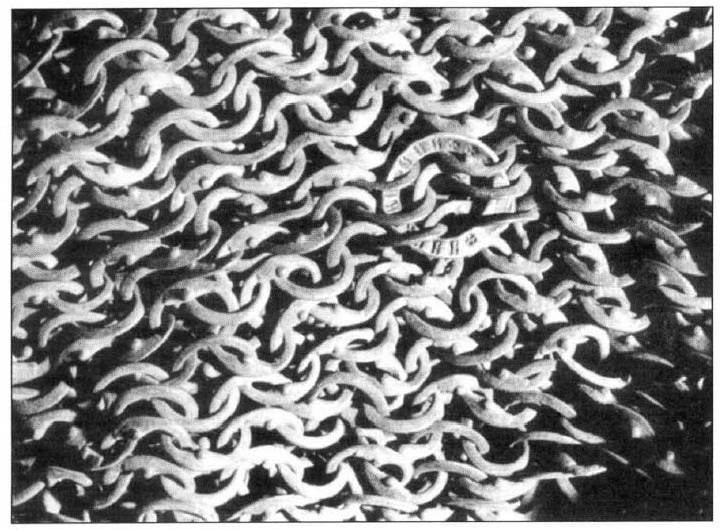
Chain weaving. Large ring - a sign of the master
Excellent safety features combined with design flexibility ensured popularity and wide distribution to chain mail. To some extent, it turned out to be a unique armor, combining flexibility, small thickness, mobility and acceptable protection against sliding and accidental impacts. Mail and was not intended to protect against injections and chopping direct blows: it had to protect mainly from cutting (sliding) blows - after all, it was assumed that the fighter could reflect direct blows by taking on his shield and (or) sword.
The mail did not provide reliable protection from arrows as well. Already in 50 meters from an archer or crossbowman, the soldier in the mail armor could not feel safe. A striking example is the heavy failure of Varangi in the Battle of Dirrahii - when the Varyag phalanx was shot to the flank by the Norman archers. It was for this situation that shields were of increased importance.
Since chainmail rings were made of fairly soft metal (after all, rings made of hard steel burst upon impact), such armor was cut, chopped, and pierced. Therefore, in order to depreciate the blows of the enemy, t. podstapeshnik. As such, a padded jacket was used in the East (in the 14th century cotton was known in Asia), while in Europe it was a quilted cloth (a quilted jacket stitched from 8 - 30 layers of canvas and stuffed with bristles, tow or similar material). A standard podtospezhnik - linen, cloth or leather shirt with a pad of horsehair or wool. He softened the blows, did not allow the chain mail to scratch the body, and he himself was an additional level of protection.
We also used scaly and lamellar armor of various types. Being made of metal plates, they differed in that the scales were directly attached to the lining of fabric or leather (the upper row of scales covered the lower), and the plates of lamellar armor were connected, first of all, to each other (the lower rows of plates covered the upper ones). Could they put on the chainmail.
Scaled Armor - scales are attached to the leather base
The size of the plates of the lamellar was different - from very small (by mobility, the web approached ringed) to large ones (almost the size of a person’s palm). They were at least a relatively inactive, but strong armor. Lamellae were of different shapes, bluing and gilding of the plates was used.
Scaled armor was a leather or canvas shirt, to which rivets were attached scales. The latter were also of various shapes.
Between themselves, the lamellae and the scales were fastened together with rings or a cord and were laid in layers - the fact that they partially overlapped each other was of particular importance for protection. Scaled and lamellar armor was fairly technological (consisted of a large number of identical parts). By manufacturability, they resembled chain mail, providing the owner with a higher level of protection. Sources together celebrate the high-quality "armor" of Greek production.
The combined scheme was also extended - it combined a chain mail base and segment protection. Used and worn on the armor cuirass. Plates and scales in the Byzantine Imperial Army were painted in a color assigned to a part — for example, blue and gold. It had an identifying and decorative effect - the whole imperial guard wore such ceremonial armor. There are also testimonies about the special plate breastplates that the Varang had.
In a late era stories Varangi was actually used knight armor. This so-called. brigant-plate armor supplanted lamellar. Armor XIV-XV centuries. It provided the carrier with almost absolute protection against the cold weapons used at that time.
Varyags used bracers and leggings. The bracers protected the arms from the elbow to the wrist, and the leggings covered the front of the leg.
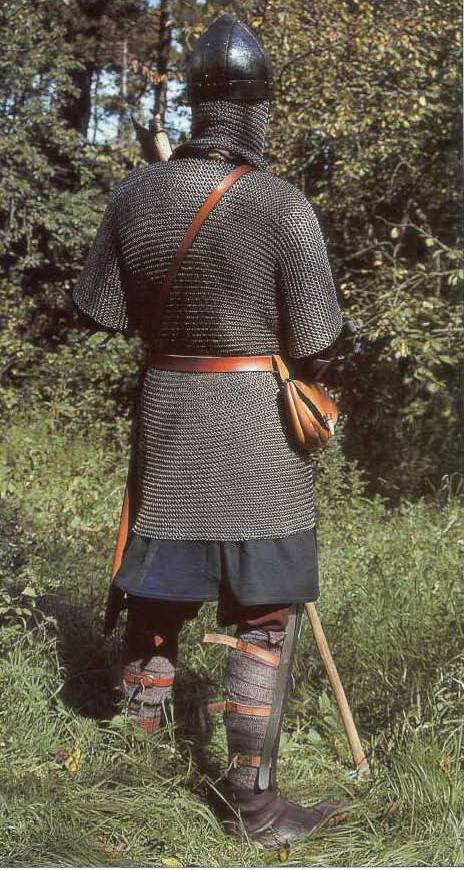
Varangian Guardsman. Leggings are fastened on the calf with a buckle, a woolen shirt is under the chain mail, flint in a leather pouch, tinder, a cup and a spoon. Modern reconstruction
The most common were banded leggings and bracers. The design was segmental - that is, they were assembled from metal rectangular strips-plates (width about 16 mm, different lengths), attached to leather straps. There were also tubular leggings and bracers, slightly tapering towards one end. Such a wrist strap consisted of 2's tubular parts connected by hinges - they were tightened (closed) on the arm with 2 straps and 2 buckles. Russian fighters Varangi even in the XIII century. continued use of ringed leggings.
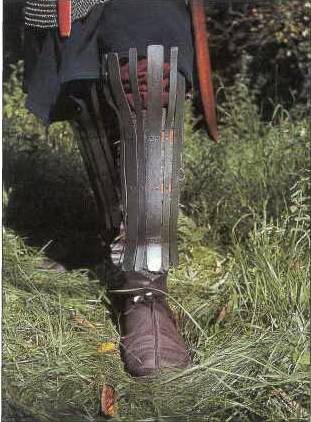
Leggings - Modern Renovation
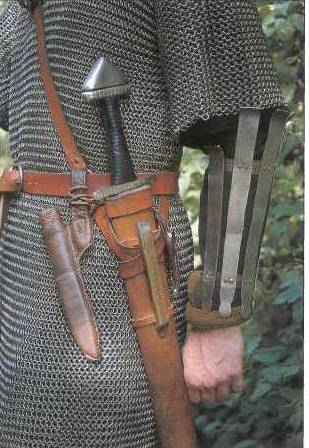
Bracers, sword and knife Varanga. Modern reconstruction. Bracelets have a banded design. The length of the metal strips is different - the longer ones cover the elbow. The band on which the sheath is hanging is passed under the waist belt. The leather case of the scabbard contained usually scissors - used for cutting hair and beard
The helmets of Varanga at the beginning of its history were a frame construction characteristic of the whole of northern Europe.
The frame - that is, the hoop of iron or bronze bands - was covered with plates of metal or covered with riveted metal sheets or leather. He had, as a rule, 4 vertical edges, supplemented by a half mask and a top. Segment (prefabricated) helmets and other structures were used.
The form of such helmets is hemispherical or simple conical. There are helmets Scandinavian and Russian samples. In X - XI centuries. often met high and more pointed so-called. "Caucasian" segment helmet. Helmets of this type are found on the territory of Russia and Ukraine. There are several images of such a helmet XI in, made in the east of Romania. An interesting helmet from Yasenevo (IX - X centuries) - the original design.
Forged conical helmets. Nasal plate speaks of northern origin
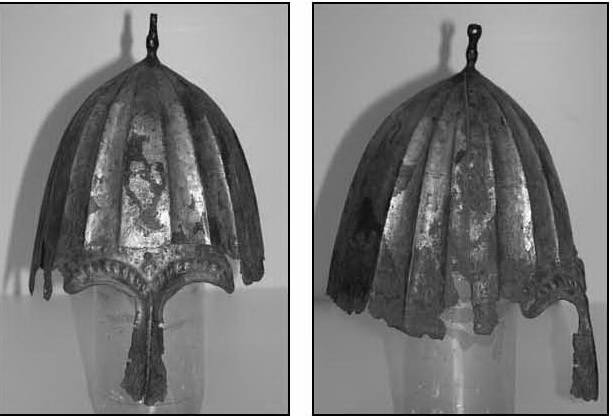
Helmet Yasenevskogo type. This helmet of the end of the XII - the beginning of the XIII centuries, belonging to the Russian soldier - is a witness of the Russian influence in Varang
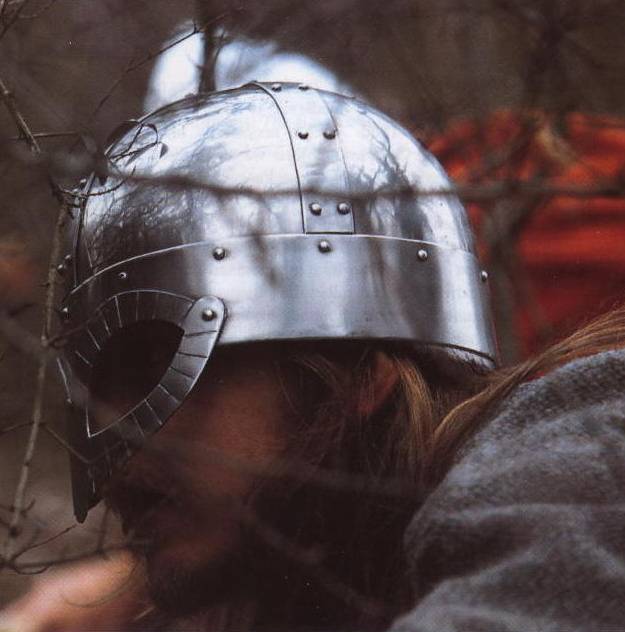
Varangian helmet - modern reconstruction
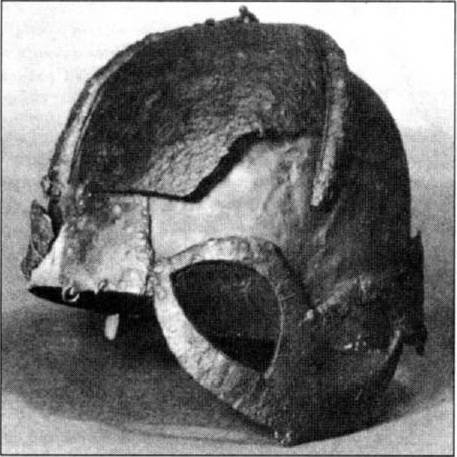
Varangian helmet X century
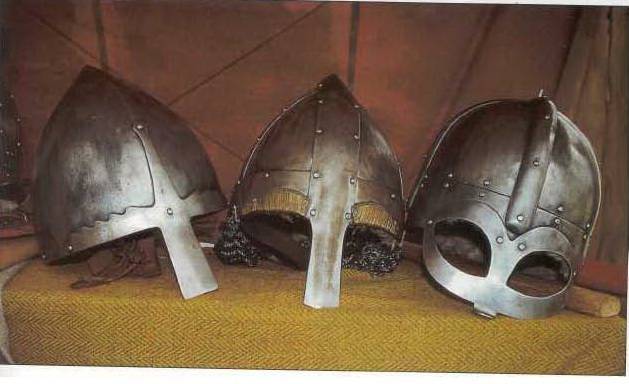
Helmets - in the center and on the right of the frame construction, on the left - solid forged
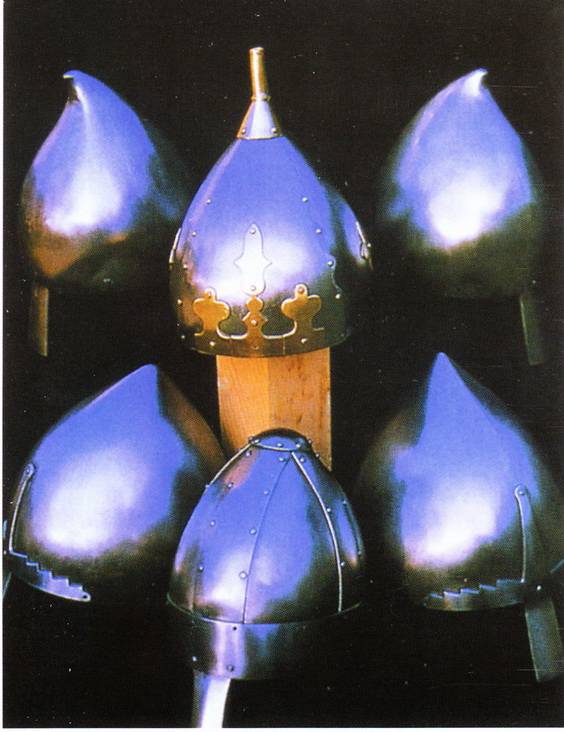
The central helmet is of the Russian type and is equipped with a plume holder; on the segmental helmet located below, visible parietal plate
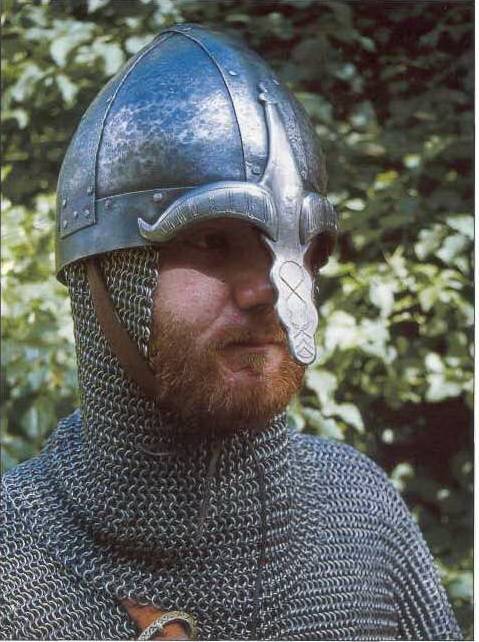
Helmet of segmental design - you can see eyebrows, mail aventail, leather lining, nose mask protects not only the nose, but also the mouth
Some of the helmets had a reinforcement lining. Similar pads on the helmet cup appeared at the beginning of the 3rd century. on the helmets of the Roman legionaries. Such a reinforced helmet could withstand a powerful chop. The illustrations of Chronicles I. Skilitsi make it possible to see that the Russian Yasenevsky helmet was spread as widely as the so-called. crest helmet (with lining on the cup).
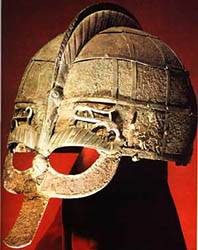
"A ridge helmet" - characteristic large orbits and noseplate are visible
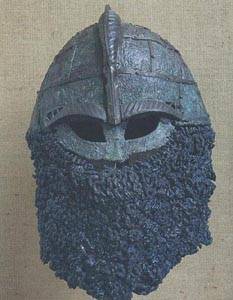
On this helmet, the bottom of the face and the neck are protected by chain mail barlets attached to the edge of the helmet and the lower edge of the half mask.
There was also an early modification of the so-called. "Iron cap" - a simple helmet with brim. Spread across the Mediterranean in the XII century. helmet - "Phrygian cap" could be present in the arsenal of the Varangian Guardsman.
Norman helmets - a possible borrowing in Comnin conflicts, also an attribute of the Normans in the imperial service
The dome-shaped forged helmets were also actively used - they were made from a single sheet of steel and had increased reliability.
There is interesting information on the application of the identifying coloring of warang helmets (the helmets of dark blue were worn by the soldiers of the Harald unit in Sicily, and the green ones by the Varyag guard of John II Comnenus during the battle of Eski-Zagre).
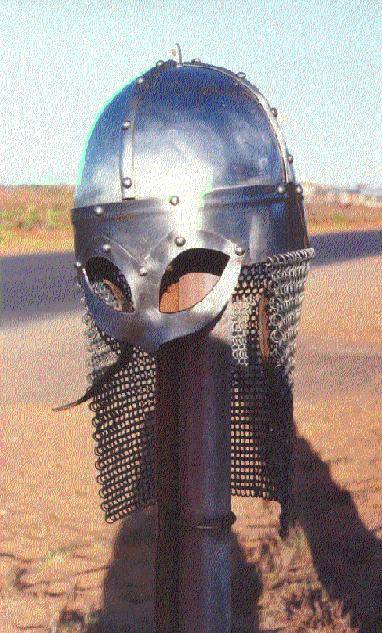
Helmet with barmitsa
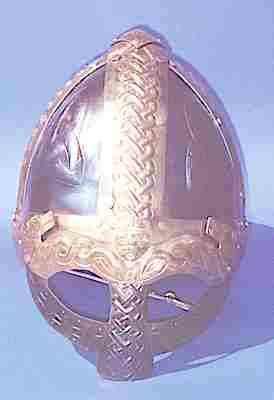
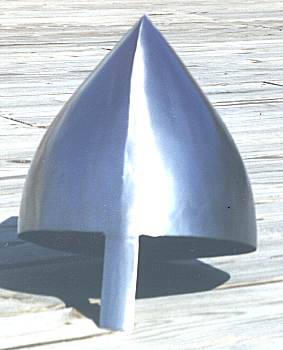
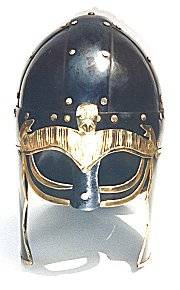
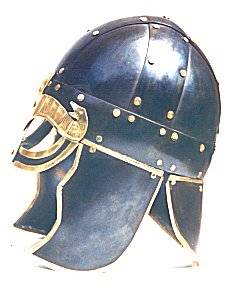
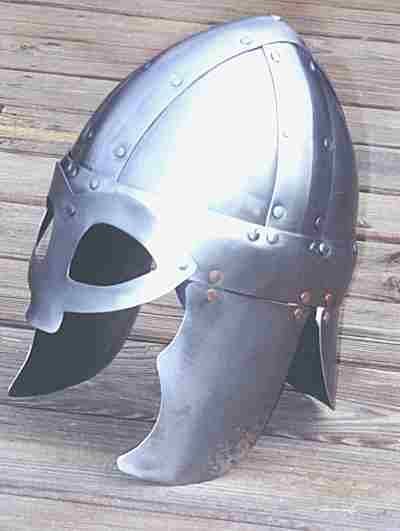
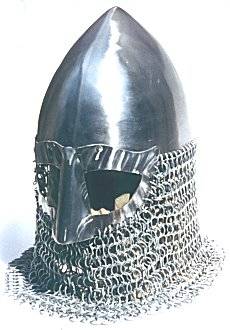
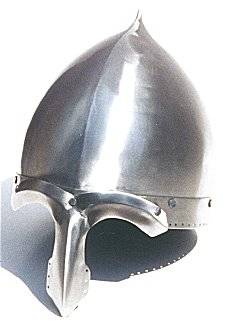
Helmets
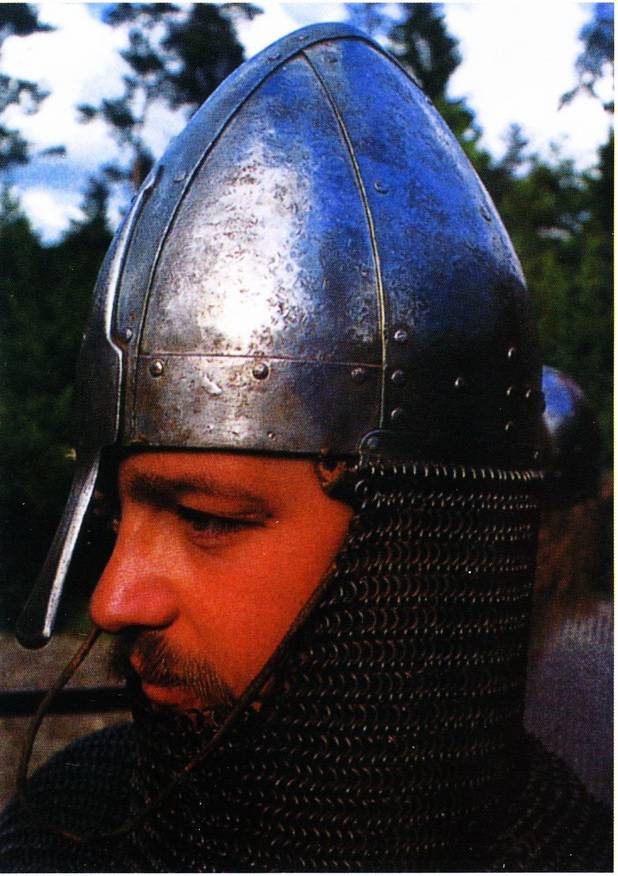
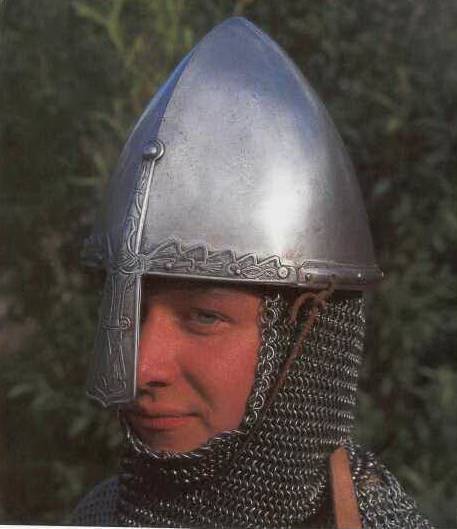
Head protection of a warrior of the Varangian Guard - modern reconstruction
Helmets end of the XII - the beginning of the XIII centuries. The sample is interesting inlaid (gold-plated brass) in the form of a figure of a shield bearer. Such helmets were probably issued to the Vikings in the defense of Constantinople in 1203-04.
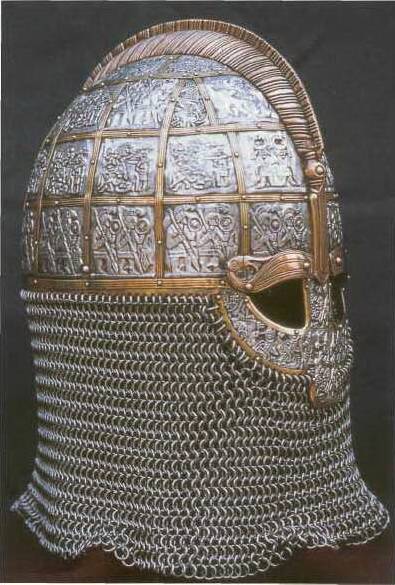
Reconstruction of the officer helmet Varang X - XIII centuries. Characteristic features - dominoes, bronze eyebrows, decorated with images
Helmets were worn either alone or in combination with a chain mail hood. A leather cap comforter was used - a cap (it was convenient both as a shock absorber to the helmet and when worn on its own). Used and additional shock absorbers under the helmet - leather, cloth, wool. Particularly interesting are the liners mentioned by the sources, which resembled a soft hat with ears (if necessary, ears were tied under the chin) - such a liner (Byzantine "ear-flaps") is associated with Russian influence in the Varangian Guard. Lining cloth and leather to the helmet fastened with rivets.
The helmet could be equipped with a nazatylnik, headphones, mask, temporal plates, chin strap. The warriors of Varangi loved masks-masks (covering the entire face), half-masks (covering half of the face), eye sockets, and nasal plates. The eye-plates and nasal plates (nasal plates, nose pads) are a characteristic feature of the helmets of northern Europe (Byzantine helmets had patches and barmits, but there were no bow pads). Metal eyebrows were also a characteristic detail.
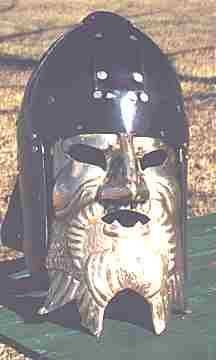
Variant of the mask
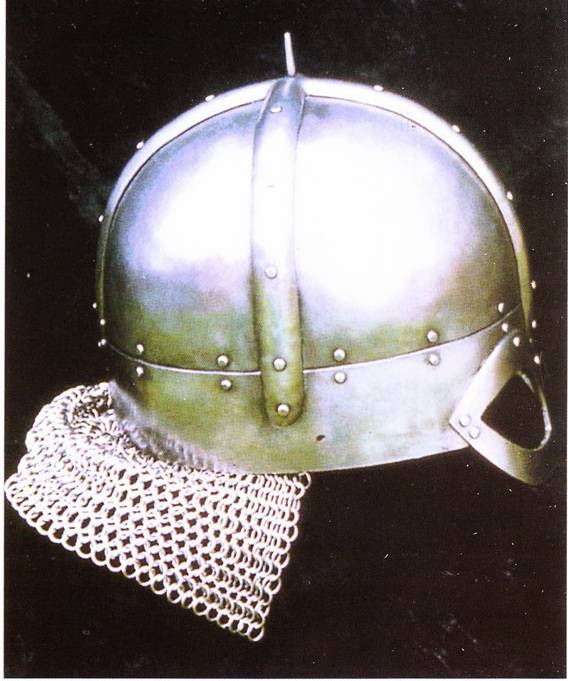
Helmet with chainmail back piece
Helmet Varanga usually had a barmitsa. Barmitsa - an element of the helmet in the form of a grid, which framed the helmet along the bottom edge. It was needed to protect the neck. Barmitsa could be quilted or in the form of leather stripes-pterig. Figurative sources indicate that the helmets with fields at the beginning were also equipped with barmitsa. Widely used kolchuzhnye barmitsy, covering both the lower part of the face and neck. Often, such a barmitsa had a leather lining. Sometimes the Varangian helmet did not have a barmitsu, but a chain mail helmet.
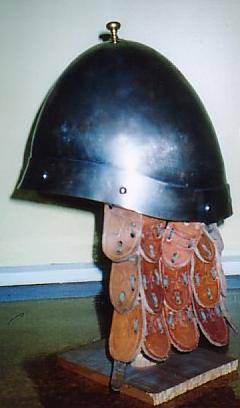
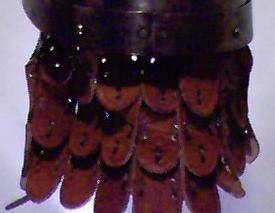
Variants barmitsy. In this case, leather pterigi
The helmet and its parts were silver and golden - depending on the capabilities and desires of the warrior.
Then both Byzantine and modified Western European helmets appear. They looked like a sphere or cone.
In the XI-XII centuries. the full defensive complex of the Varangian Guards (long mail or armor, a helmet with a barmitsa and a chain mail mask, leggings and bracers) turned the warrior into a peculiar cataphract on foot - only his eyes glittered against the steel wall. Already the ability to effectively and dynamically fight in such robes (and without the help of a horse) turned the warangs into one of the strongest fighters in Europe.
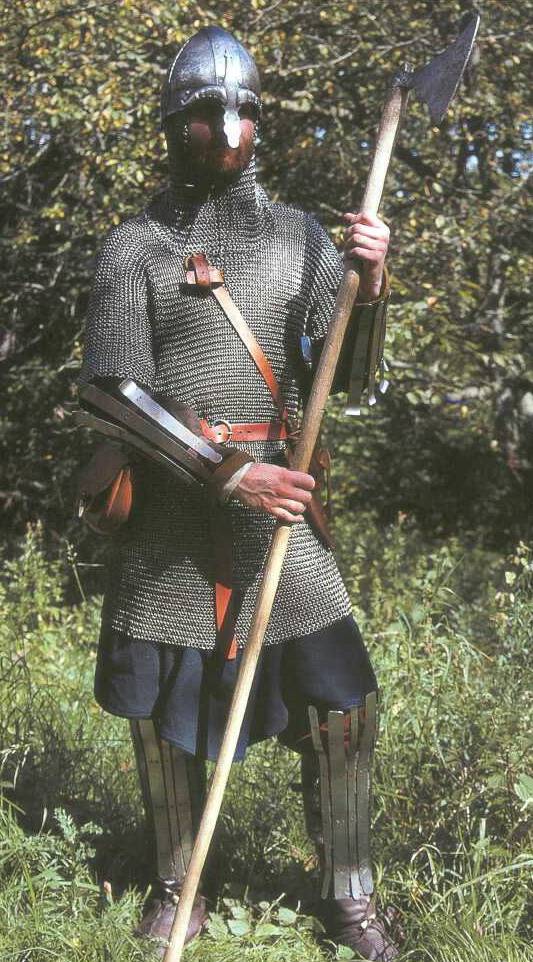
Fighter of the Varangian Guard in full dress - modern reconstruction
In the X-XII centuries. fighters of the Varangian Guard used shields mainly of round shape (diameter 80 - 100 cm), and in 20-s. XII century. gradually come into fashion t. "Kite shields".
Scandinavian weapons IX - XI centuries. It can be seen that the shield is made of boards
Almond-shaped European shield to the 3 of the fourth quarter of the XII century. was quite large and massive - he had to close the fighter primarily from the spear ram. Such a shield was used by the Vikings. He was held by an elbow and a hand through the straps. The belt through the neck allowed, if necessary, to throw the shield behind him and wield with both hands.
Russian shields were also used, both rectangular and drop-shaped. In the sources they are called - "long." Drop-shaped shields reached a height of 1,1 m and more (most often there were 95-cm shields). Both types were equipped with 2 leather or rope handles, attached with a ring to the back side of the shield. The arms were held with a hand - not using the forearm.
The boards were made of wooden planks, boards, or from a single piece of wood. 2- or 3-ply shields were also made - the direction of the fibers of each layer was perpendicular to the other layers, which increased the strength of the structure.
Later, triangular shields fashionable in the west appear. But on the use of Varangas in the battle of the latter types of shields there is virtually no reliable information, whereas the traditional round, drop-shaped and almond-shaped shield allowed: holding it in the left hand, use the ax in the right hand against the enemy’s left side, or by throwing the shield on its back, immediately two hands act ax.
Hence heightened attention to the issues of protection of the warrior's corps — after all, in the most crucial period of the battle, the shield could be on the back of the Varanga.
Of course, the national complexes of protective equipment also left an imprint on the appearance of the Varangian Guard. Thus, characterizing the protection of the Norman warriors of Varangi, “Aleksiada” reports that “Celtic armor” includes a shirt made of intertwined metal rings. The iron from which the mail was made was of such high quality that it reliably protected it from arrows. The shield is elongated - rounded and wide towards the top and tapering towards the bottom. The shield reflected any arrow, and the armor made such warriors almost invulnerable. Norman mailmail sometimes even reached the ankles. Another feature of the Norman security complex was the presence of a small hole at the belt level - the sword slipped into the sheath, which was at the thigh under the mail. Another difference was the presence of a small valve in the upper part of the chest - it had a cloth or leather lining, designed to protect the lower part of the face (and was an integral part of the chain mail). In battle, this valve with the help of 2 tapes rose and protected the neck and lower part of the face.
For the Anglo-Saxons, characteristic umbrellas were metal umbons (umbon - a conical or hemispherical pad), located in the middle of the shield and protecting the hands from punches that pierce the shield. The standard diameter of an umbon, which was forged from a single piece of iron, is 15, see. Umbon could be flat or conical. 4-5 rivets with a head diameter up to 50 mm held it in place. The metal parts of the shield were often gilded or silver, and the edges of expensive shields were further bound.
Umbons Anglo-Saxon shields. A strong blow with a umbon could destroy the enemy
The Normans and the Anglo-Saxons were more willing to use drop-shaped shields and used chain mail pillows. A shield rounded from the top and pointed downwards was composed of boards lined with leather and worn on the straps on the forearm (shoulder strap - for carrying the shield behind the back).
To be continued
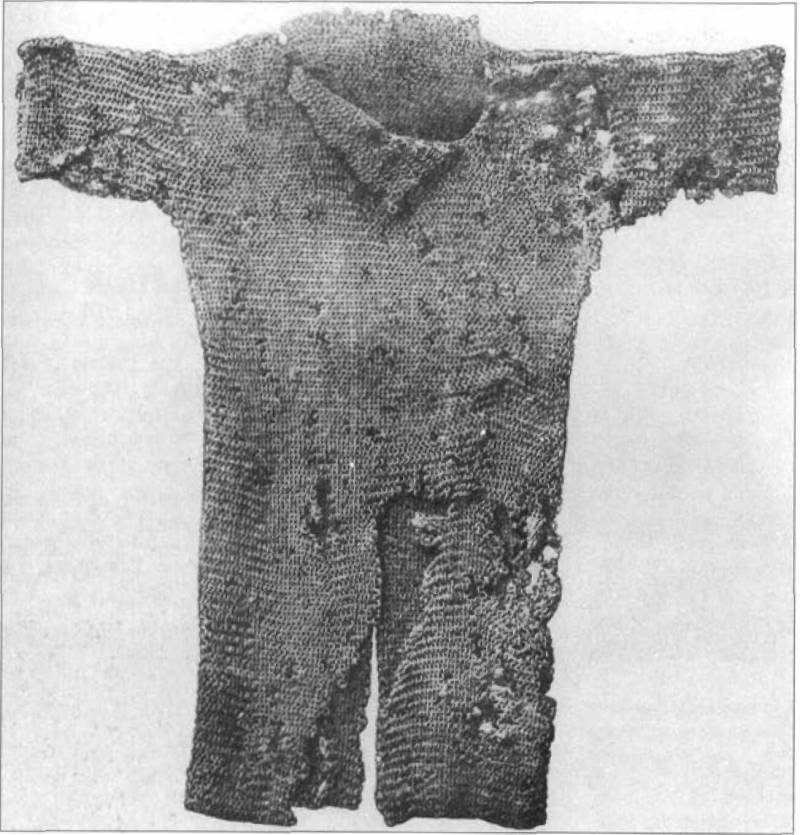
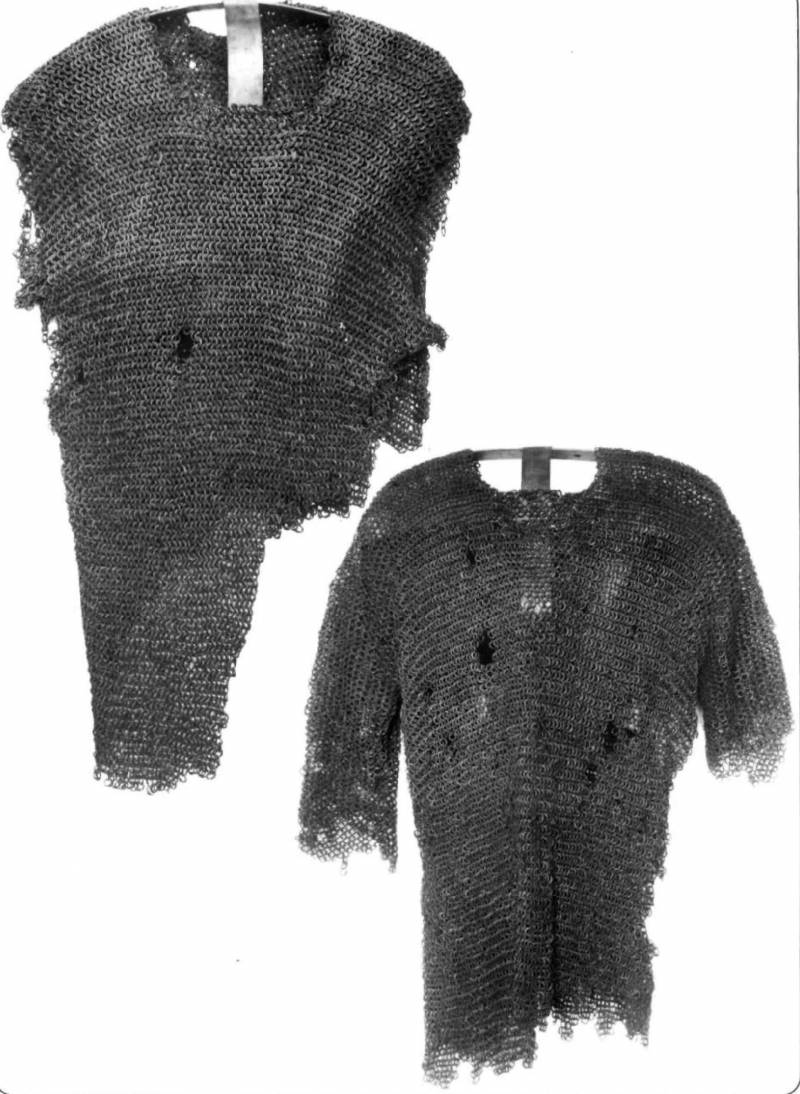
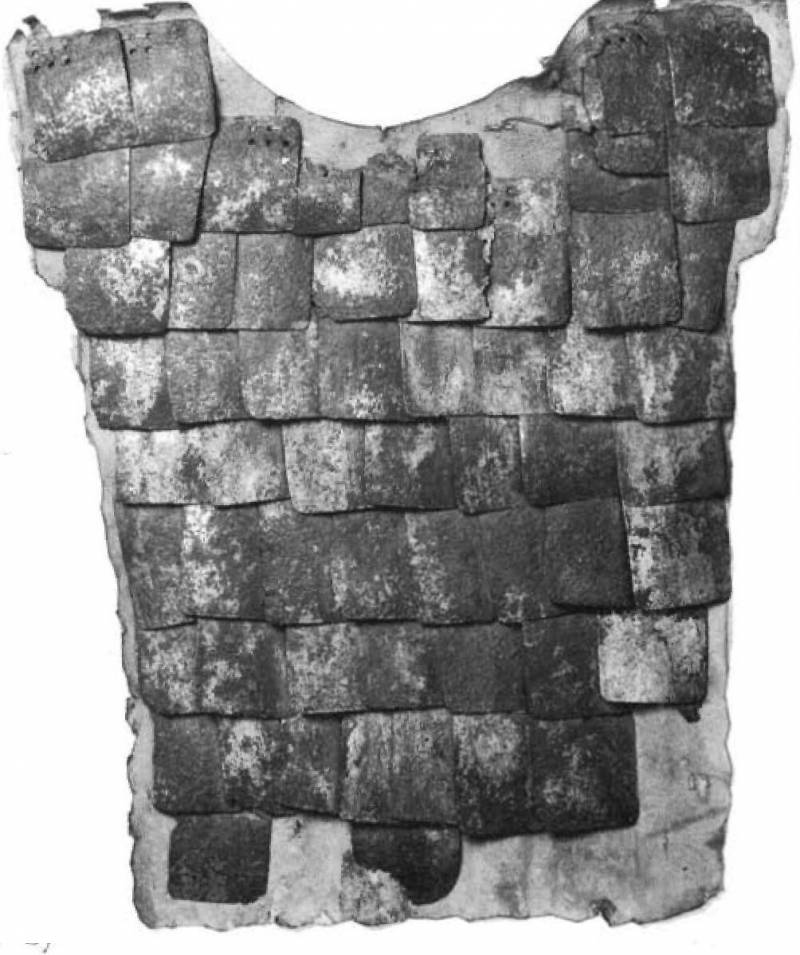

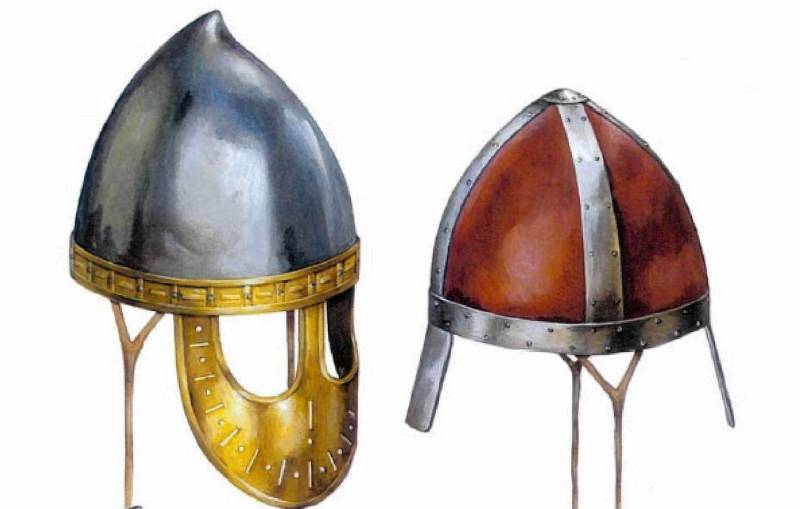
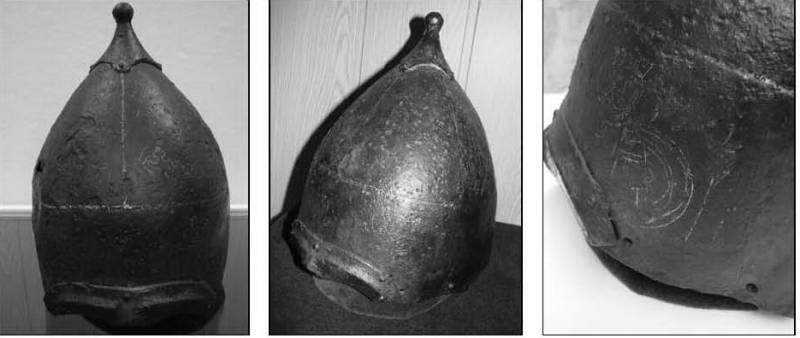
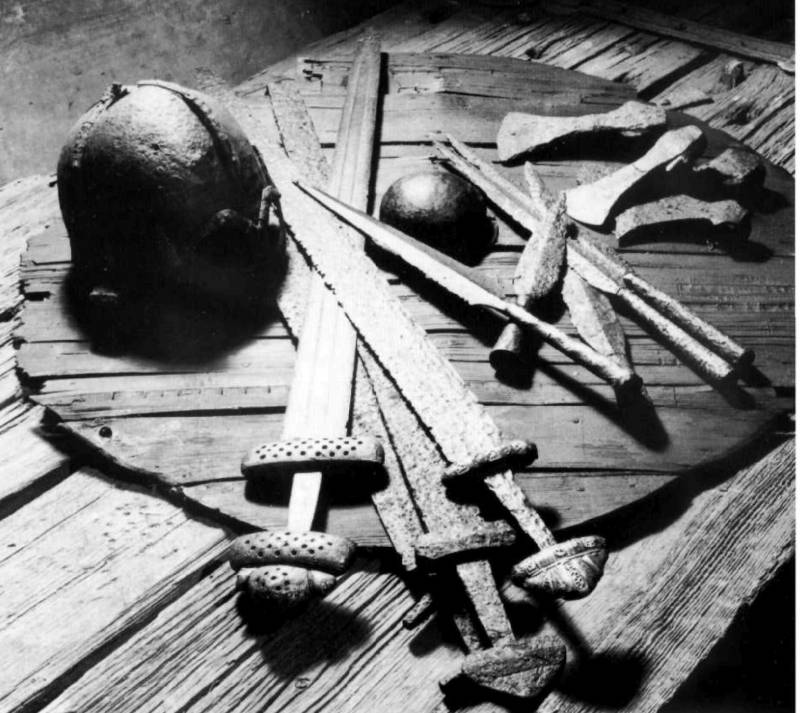
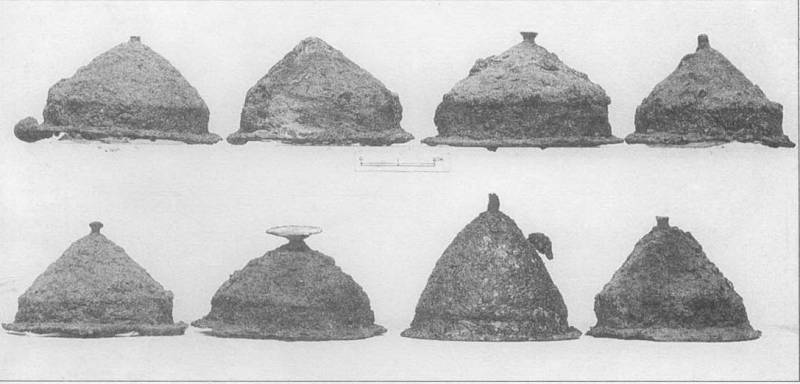
Information